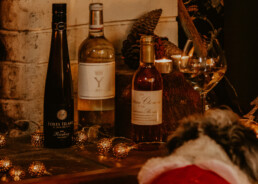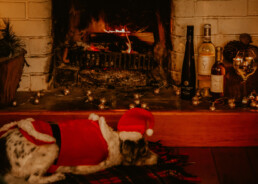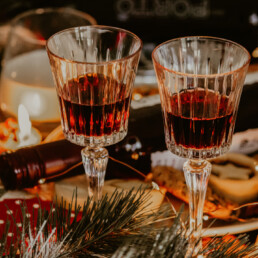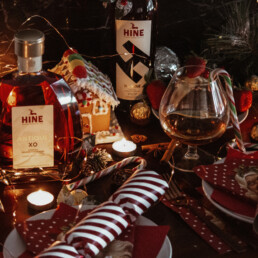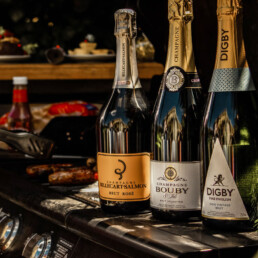You know the saying "great things come in small packages" – well, dessert wines are the perfect 'small' gift with a powerful personality...
Whoever said you can’t have your cake and drink it too has obviously never experienced the magic and majesty of dessert wine – or in our local lingo “stickies”! Whether you are pairing it with an actual dessert or sippin’ it on its own, a glass of dessert wine is THE best way to round out a fun food-filled occasion.
But why is dessert wine so often overlooked or underrated? Is it because people are dining less formally, or because it isn’t on-trend anymore, or perhaps we have become obsessed with all vinous pleasures needing to be “dry”? Yet those in the Northern hemisphere are still buying up large. They know what an absolute indulgence and a luxury dessert wine is to sip and savour, fabulous on its own or bringing to life a range of desserts or cheeses. And many of these finer examples can age 50+ years because sweetness and acidity preserve their freshness, yet go on to develop exquisite nuttiness, butterscotch and caramel spice characteristics with age.
So, let’s get to know our “stickies” better – how they are made: Generally dessert wines are created when the grapes stop fermenting before all their sugar has turned to alcohol. This “residual” sugar is what makes these wines taste so full in your mouth and sumptuously sweet. The fermentation either stops naturally or the winemaker stops it by the addition of sulphur dioxide. The best sweet wines are made from grapes that have this super concentrated sugar, but are equally balanced out by crisp clean acidity. Cleverly, they hoodwink your palate into believing it’s not as sweet as it actually is.
Believe it or not, there are multiple ways in which dessert wines get their lip-smacking sugar content. Curious how? Read on…
Late Harvest Wines
Late harvest wines are made from grapes that are left on the vine until later in the harvest season, allowing them to get super-ripe and gain a lot of sugar. As grapes hang on the vine longer they become even sweeter and more “raisined” resulting in grapes with concentrated sweetness. In Alsace, late harvest is called “Vendage Tardive” and in Germany it’s referred to as “Spätlese”.
Any grape left on the vine to ‘raisin’ can be used for late harvest wines, even reds. Generally, the most popular late harvest grapes used are Riesling, Chenin Blanc or Sémillon grapes. However, in many countries, like New Zealand and France, they also do Late Harvest Gewürztraminer and Pinot Gris.
One of our faves from our portfolio is Domaine Vincent Carême Moelleux – a late harvest Chenin Blanc – hailing from Vouvray, perhaps the most famous Loire Valley appellation for Chenin. The glorious Chenin grape shows itself to be quite a chameleon – the sweeter versions range from demi-sec, moelleux, to liquereux indicating the presence of residual sugar. These wines develop golden apple, honey, beeswax and citrus blossom characteristics.
Noble Rot Wines
Noble rot wines are a version of a late harvest wine, but the healthy grapes are actually attacked by a fungus called Botrytis Cinerea. While it sounds (and looks) a bit disgusting, noble rot adds truly divine nuanced flavours to sweet wines. The noble rot (botrytis) punctures the grape skins to dehydrate them and concentrate flavours, sugar and acidity. While dessert wine producers hope for botrytis, it all depends on the right vintage conditions, and some years will have more botrytis than others – ideally with foggy, humid conditions being best to develop the fungus on the outside of the clusters. Botrytis adds its own unique flavours such as ginger, saffron, marmalade, orange essence and honey.
Some of the finest examples of dessert wines affected by noble rot are:
Sauternes: Who hasn’t heard of the world’s greatest sweet wine – Château d’Yquem? Arguably one of the most collectible investment wines on the market. Sauternes is heralded as ‘the King of Dessert Wine’. This sweet Bordeaux wine relies on the friendly fungus, noble rot, to give it an ageing potential of over 100 years. It is the gold standard when it comes to botrytis-affected wines, made from the Sémillon grape, along with Sauvignon Blanc and Muscadelle.
During harvest, the producers work through their vineyards many times, selectively picking only noble rot-affected grapes as the fungus develops. Though at first glance these shrivelled, purple, fuzz-covered grapes seem rather ugly, they transform into an unctuous, lusciously sweet dessert wine that is typically aged in oak before release. A wine worthy of worship!
Tokaji (or Tokay): Who would have thought that the other great sweet wine of the world would come from Hungary? This dessert wine is prized for its rarity, cellar worthiness and expense. Rich, honeyed and orangey with hints of caramel – it is surprisingly good with blue cheeses.
Principally made from the local Furmint grape with a few other indigenous varieties added, it is high in acidity and very susceptible to botrytis. Tokaji (not to be confused with its region, Tokaj) is best known for its aszú version, made from late-harvested, shrivelled, botrytis-affected grapes gathered in containers called puttony. These uber-sweet, barrel aged Tokaji Aszú wines are low in alcohol, have a viscous mouthfeel, and are quite honeyed. There is also a teeny-tiny amount of Tokaji Esszencia produced, which is made only from the syrupy free-run juice that comes from the aszú grapes. It is possibly the sweetest wine in the world at over 900 grams per litre of residual sugar! It is incredibly rare, can age for over a century and is typically sold by the teaspoonful. Now that’s a precious drop!
Elsewhere in Europe, the Germans have the Pradikat system which effectively is a government regulated ripeness level designation. At the top of the scale with a higher proportion of botrytised-affected grapes is Beerenauslese (BA) and the rare, wallet draining Trockenbeerenauslese (TBA) wines…
Ice Wine (Eiswein)
As the name of this dessert wine suggests, ice wine can only be produced when a vineyard’s temperature drops below freezing, causing the water within the grapes to freeze but harvested before the freezing damages the grape. Grapes are pressed while the water within them is still frozen. Because of their need for such drastic temperatures, ice wines are usually only produced in Canada, Germany and a few other cooler climate countries. The wines are generally made from Riesling grapes, and the flavours of this wine are of extremely concentrated lush fruits counterbalanced with a crisp elegance. Due to their rarity and extreme difficulty to make, true ice wines demand some pretty hefty prices – though if you have the chance to try one, it’s definitely worth it!
Passito
Otherwise known as the ‘appassimento’ or ‘passerillage’ technique, Passito style wines are made by leaving grapes out to dry to concentrate their sugars. First, the grapes are left to dry out on the vine, then laid out to further dehydrate on straw mats or, nowadays, hung from ceilings in warm rooms indoors. Popular Passito style wines include Recioto della Valpolicella (Verona, Italy), Vin de Paille (popular in Jura, France), Vin Santo (Tuscany) and Passito di Pantelleria (Sicily).
At Dhall & Nash we have the superbly complex Sartori “Rerum” Recioto della Valpollicella which is made from red grapes – Corvino, Rondinella, Molinara and Cabernet – undergoing the Passito technique of drying on racks for 3-4 months, they lose a third of their weight and often even develop botrytis. After fermenting for 40 days, the pressed juice spends two years in barrel. The result is an intense sweet wine tasting of spices, nuts and rich dark fruits. Divine with your gran’s xmas fruit cake or mince tarts, and also with gooey pungent washed rind cheeses like Kapiti Rarama or Italian Taleggio.
Finally, the best news of all? These very hard-to-make wines are actually incredible value, possibly as they are slightly overlooked in our fast-paced contemporary culture. They deserve to be slowly sipped and appreciated at leisure with conversation and reflection. A half bottle, lightly chilled, will serve 6 quite easily.
So, next time your guests say “I don’t like sweet wine”, urge them to throw their caution to the wind, cut a slice of the best salty Roquefort or Kikorangi blue cheese, and sample one of the great wine-tasting experiences the world of wine and Dhall & Nash has to offer! We promise, your fellow dining companions will thank you for the sublimely uplifting experience of a sexy sticky!


